Dennis Mitchell of Blissfield, MI knows that the worst threat truckers face is the extinction of their breed. And, to drive that point home, he had a buffalo painted on the top of his hood. Like the nearly-extinct buffalo, the American trucker’s future is also in jeopardy!
Over the last few decades, Dennis has driven over 4 million miles – two of those million in the older Peterbilt (with the buffalo on the top of the hood), and the other two in a newer Peterbilt he still runs today. During that time, Dennis has spread the word that truckers are the last gypsies and cowboys of this land.
In an effort to pass his lifetime of trucking knowledge and experiences to the next generation, Dennis will now be writing an ongoing column in 10-4 Magazine called “The Veteran’s View” – an homage to his service in the military and decades in trucking. His first article here attempts to redefine what the term “old school” really means. Enjoy.
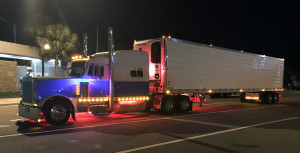 Every day I listen to young drivers refer to old or outdated equipment as “old school” – they recognize the style, but don’t truly understand the purpose or intent of the design. Don’t misunderstand me, I too like to see the reconstructed or refurbished iron, however let us keep in mind what it was like when those trucks first rolled on the American highway scene. The term “old school” had more to do with how we truckers operated our equipment, and less to do with the equipment itself.
Every day I listen to young drivers refer to old or outdated equipment as “old school” – they recognize the style, but don’t truly understand the purpose or intent of the design. Don’t misunderstand me, I too like to see the reconstructed or refurbished iron, however let us keep in mind what it was like when those trucks first rolled on the American highway scene. The term “old school” had more to do with how we truckers operated our equipment, and less to do with the equipment itself.
I’m a Peterbilt connoisseur – a lover of the square hood – and I think a truck should look and sound like a truck, not a plastic version of some futuristic mode of transportation. With that said, let’s go back to my first point. What makes someone or something old school? There’s an attitude or a belief, if you will, in how you do the thing you do. In our shop, when things go wrong, we use the phrase, “That’s Truckin!” That’s not to say we don’t screw things up from time to time, however when we do, it’s how we fix the problem or the way we look at avenues to the solution that makes us old school.
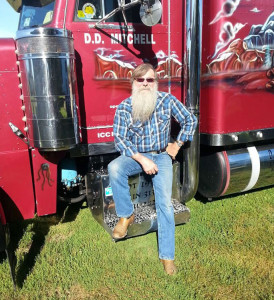 Some of these old trucks were built using basic tooling, not the high-tech things we have today. So, to fix or operate them requires an understanding of how they were originally put together. Ask yourself, where can I get all this knowledge? There are many resources, but the best is still from an old hand, a term used to describe a reliable and experienced driver.
Some of these old trucks were built using basic tooling, not the high-tech things we have today. So, to fix or operate them requires an understanding of how they were originally put together. Ask yourself, where can I get all this knowledge? There are many resources, but the best is still from an old hand, a term used to describe a reliable and experienced driver.
Back in the day, the description or handle of “driver” wasn’t just handed out, you had to earn it. Seat time was required, and along with that, you needed the skills to solve problems – all kinds of problems. If you blew a tire on the Ohio Turnpike at 3:00 am, it was your job to get yourself fixed and rolling. Back in the day, there was no calling the T/A for mobile tire service. And when your clutch gave up and you had a load of cattle headed to Philadelphia onboard, you needed to be a little creative (like using a couple pallets and a pallet jack to get it fixed on the side of the road).
Knowledge isn’t the only thing required to be old school, there was a code we lived by, and many of today’s drivers still honor that code (Brothers of the Highway or Sisters of the Wind). We watch over each other and we have each other’s back – none of the dog-eat-dog chase the rates to the bottom junk that has become so common today. Back in the day we were competitive, too, but we weren’t trying to put each other out of business. When someone broke down and was on the side of a road, every truck stopped, even if it was your competition. Most of us carried a tool box, and what one driver didn’t have, another one might. And everybody had an opinion on the problem.
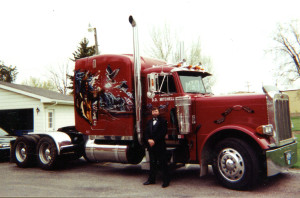 Sometimes the problem couldn’t be fixed on the side of the road and a tow or trailer drop was needed. Can you imagine calling your dispatchers today and telling them that you were going to deliver a load of cattle to Kansas City because some other driver broke down? Then, you’re going to deadhead back and pick up your trailer in the morning. Oh yea, and the other driver is going to help you drive. That was the “old school” way, and I was fortunate to have lived it. Sometimes, just to be around those people, with a can-do attitude, gave me more knowledge than any school of trucking could ever do.
Sometimes the problem couldn’t be fixed on the side of the road and a tow or trailer drop was needed. Can you imagine calling your dispatchers today and telling them that you were going to deliver a load of cattle to Kansas City because some other driver broke down? Then, you’re going to deadhead back and pick up your trailer in the morning. Oh yea, and the other driver is going to help you drive. That was the “old school” way, and I was fortunate to have lived it. Sometimes, just to be around those people, with a can-do attitude, gave me more knowledge than any school of trucking could ever do.
I think most of today’s drivers think of the old days as that time when deregulation was put into place. The 1980s and 1990s became known as the Wild West of trucking. That’s when most of the big brand carriers of today got their start. Prior to that, a lot of us only ran a regional circuit or a dedicated route for a local freight company. There were some owner-operators, but not on the scale we see today. These guys had the fever bad, and they lived a hard life of miles and sacrifice – they gave up everything for the love of the road. None of this “snowflake” stuff we have today, where you can shower every day and run 70-mph on a smooth sheet of blacktop.
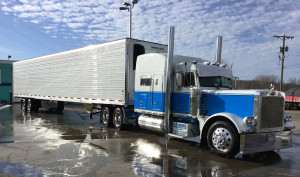 Back in the day, truckers ran the two lanes in 220-hp trucks that didn’t have power steering or air conditioning. As cool as it is to see an old Peterbilt with two sticks (I still have one with a 1693 Cat), they were a pain in the butt to drive, especially if you locked the boxes up between gears. When that happened, you had to stop and climb under your truck to free the linkage, usually using some blunt object like a hammer or long rod. I’ve since fixed mine with a slide hammer attached to the shift rods, which is a really slick trick an “old hand” once showed me.
Back in the day, truckers ran the two lanes in 220-hp trucks that didn’t have power steering or air conditioning. As cool as it is to see an old Peterbilt with two sticks (I still have one with a 1693 Cat), they were a pain in the butt to drive, especially if you locked the boxes up between gears. When that happened, you had to stop and climb under your truck to free the linkage, usually using some blunt object like a hammer or long rod. I’ve since fixed mine with a slide hammer attached to the shift rods, which is a really slick trick an “old hand” once showed me.
These days, every large car worth its weight has a stretched frame and a dropped air-ride front suspension. You know that’s cool, but ask yourself, why did they ride that high in the first place? Until around the late 1980s, most of the trucks on the road had spring ride “rodeo” set-ups (a Reyco spring stack was the most popular in our area). If you were privileged enough to drive an over-the-road truck, one of those big Petes or a Kenworth, then you might see an air-ride drive axle or maybe even an air-ride cab. These trucks were (are) the most desirable platforms to build, so it only made sense to cut the old frame off and start over with a new low riding air set up. It’s still cheaper to buy a cutoff from the salvage yard than it is to rebuild an existing one, so why not have the best of both worlds?
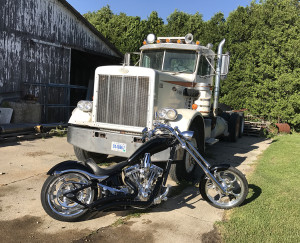 I’m writing this and smiling at the same time, thinking of some “rodeo” rides I took across I-80 back in the day. I drove a cabover International, that’s right, a 13-letter barnyard spreader, and was damn glad to have the job. The wheelbase was 144 inches, and there was no “air” anywhere, unless you count the distance between the seat of my pants and the top of the chair cushion (I would wear a kidney belt to ease the jarring I got all night crossing Pennsylvania). But hey, I was trucking, and that was really all I ever wanted to do. Back then, no one complained much because we were all in the same boat. The trucks were underpowered and overloaded, and most of us didn’t know how to properly fill out a logbook if we had to.
I’m writing this and smiling at the same time, thinking of some “rodeo” rides I took across I-80 back in the day. I drove a cabover International, that’s right, a 13-letter barnyard spreader, and was damn glad to have the job. The wheelbase was 144 inches, and there was no “air” anywhere, unless you count the distance between the seat of my pants and the top of the chair cushion (I would wear a kidney belt to ease the jarring I got all night crossing Pennsylvania). But hey, I was trucking, and that was really all I ever wanted to do. Back then, no one complained much because we were all in the same boat. The trucks were underpowered and overloaded, and most of us didn’t know how to properly fill out a logbook if we had to.
Talking on the CB was life to most of us, and the bigger your “radio” the more popular you were. Everyone talked to the big strappers, who were mostly union drivers with money to burn, and the rest of us just listened. It was fun and mostly a family show, without the vulgar language we hear today. Once again, that’s that “learning by example” thing. Old school was how you conducted your actions and not so much what you were doing them in (are you listening?).
I recently loaded next to a young driver in Florida that had a vintage 359 from back in the day. This rig was not one of those candy store trucks you see in the glossy pages of a book, but a rig in its original splendor, cracked fenders and broken steps included. We talked for at least an hour about trucking, the rates, the new ELD regs and a lot of other things, but during that entire time, we never needed to insult or belittle anyone, and no name calling or bad mouthing was required – wow, what a pleasure. I felt a bond with that driver, but I never did get his name – I guess it really wasn’t that important. What was important was the comradery, that “Brotherhood of the Highway” thing. I left him knowing more about trucking than I did when we first met.
I think the most valuable lesson in the world of transportation is when a new generation learns its lessons from the past generation. Each of us must be prepared to pass on our experiences to those who follow us. They may not be the younger set, as many drivers today are second career people taking driving up later in life. And that is okay. But, they still need to get the message, and those of us who can need to pass it along to them. Did I mention that young driver in the cool old 359 was definitely “old school” and I don’t think he was 30 years old yet, but he already gets it!
This article is presented to you by a humble and respectful driver of over 40 years on the highway. Like so many of you, I eat in truck stop restaurants and stop at two-lane dives where I meet America. These are the people I serve. I respect their property and conduct myself as if I am representing all the trucking industry – because I am – and you do, too. You see, I am old school, and old school is life. Here’s how I define it – with an acronym:
O – Outlaw
L – Lonely/Lucky
D – Dedicated/Dependable/Driver
S – Savvy/Smart/Strong
C – Conservative/Creative
H – Honest
O – Owner
O – Operator
L – Life
I am of the outlaw mind set and I live a lonely life, yet I think I am lucky to have it. I’m dedicated to my customers, dependable to my brokers, and answer to the handle of driver. Living on the highway, one must be savvy, smart and strong. In this crazy world, one must be conservative with their resources and creative with their actions. Honesty is still the best policy, especially when you are the owner and your name is on the door. No one can do your job for you, only you can be that operator, the one like your mentor from days gone by. Trucking is “LIFE” – give me one more helping of White Line Fever, because I am fueled-up and ready to roll, “10-4!” Thanks for listening/reading.

2 Comments
Hey there D Mitchell,
You are one of the main reasons why I snatch up the 10/4 magazine at out local diesel truck stop. I really appreciate you and your column you write on the magazine. I always skip thru the others just to read yours first. I like how you connect to us drivers, you have a special way on expressing that. I am 34 years old and due consider myself a new generation driver. But man, I really wish I knew what trucking was like back in your days! It looks like drivers now and days are always in a rush to make that delivery. Don’t really have time to just drive and enjoy the road, the views, the value of trucking. Before I forget to mention I also appreciate and thank you for your service. You are a good man Dennis i can tell! From one trucker, to the other just take it easy brother. As always waiving a big hand to yah!….10/4!
Thanks for the roses I try to bring the Highway to life .. speed safely out there and be the driver you wish others were 😊